前言
ReactiveCocoa是一个(第一个?)将函数响应式编程范例带入Objective-C的开源库。ReactiveCocoa是由Josh Abernathy和Justin Spahr-Summers 两位大神在对GitHub for Mac的开发过程中编写的。Justin Spahr-Summers 大神在2011年11月13号下午12点35分进行的第一次提交,直到2013年2月13日上午3点05分发布了其1.0 release,达到了第一个重要里程碑。ReactiveCocoa社区也非常活跃,目前最新版已经完成了ReactiveCocoa 5.0.0-alpha.3,目前在5.0.0-alpha.4开发中。
ReactiveCocoa v2.5 是公认的Objective-C最稳定的版本,因此被广大的以OC为主要语言的客户端选中使用。ReactiveCocoa v3.x主要是基于Swift 1.2的版本,而ReactiveCocoa v4.x 主要基于Swift 2.x,ReactiveCocoa 5.0就全面支持Swift 3.0,也许还有以后的Swift 4.0。接下来几篇博客先以ReactiveCocoa v2.5版本为例子,分析一下OC版的RAC具体实现(也许分析完了RAC 5.0就到来了)。也算是写在ReactiveCocoa 5.0正式版到来前夕的祝福吧。
目录
-
1.什么是ReactiveCocoa?
-
2.RAC中的核心RACSignal发送与订阅流程
-
3.RACSignal操作的核心bind实现
-
4.RACSignal基本操作concat和zipWith实现
-
5.最后
一. 什么是ReactiveCocoa?
ReactiveCocoa(其简称为RAC)是由Github 开源的一个应用于iOS和OS X开发的新框架。RAC具有函数式编程(FP)和响应式编程(RP)的特性。它主要吸取了.Net的 Reactive Extensions的设计和实现。
ReactiveCocoa 的宗旨是Streams of values over time ,随着时间变化而不断流动的数据流。
ReactiveCocoa 主要解决了以下这些问题:
-
UI数据绑定
UI控件通常需要绑定一个事件,RAC可以很方便的绑定任何数据流到控件上。
-
用户交互事件绑定
RAC为可交互的UI控件提供了一系列能发送Signal信号的方法。这些数据流会在用户交互中相互传递。
-
解决状态以及状态之间依赖过多的问题
有了RAC的绑定之后,可以不用在关心各种复杂的状态,isSelect,isFinish……也解决了这些状态在后期很难维护的问题。
-
消息传递机制的大统一
OC中编程原来消息传递机制有以下几种:Delegate,Block Callback,Target-Action,Timers,KVO,objc上有一篇关于OC中这5种消息传递方式改如何选择的文章Communication Patterns,推荐大家阅读。现在有了RAC之后,以上这5种方式都可以统一用RAC来处理。
二. RAC中的核心RACSignal
ReactiveCocoa 中最核心的概念之一就是信号RACStream。RACRACStream中有两个子类——RACSignal 和 RACSequence。本文先来分析RACSignal。
我们会经常看到以下的代码:
RACSignal *signal = [RACSignal createSignal:
^RACDisposable *(id subscriber)
{
[subscriber sendNext:@1];
[subscriber sendNext:@2];
[subscriber sendNext:@3];
[subscriber sendCompleted];
return [RACDisposable disposableWithBlock:^{
NSLog(@"signal dispose");
}];
}];
RACDisposable *disposable = [signal subscribeNext:^(id x) {
NSLog(@"subscribe value = %@", x);
} error:^(NSError *error) {
NSLog(@"error: %@", error);
} completed:^{
NSLog(@"completed");
}];
[disposable dispose];
这是一个RACSignal被订阅的完整过程。被订阅的过程中,究竟发生了什么?
+ (RACSignal *)createSignal:(RACDisposable * (^)(id subscriber))didSubscribe {
return [RACDynamicSignal createSignal:didSubscribe];
}
RACSignal调用createSignal的时候,会调用RACDynamicSignal的createSignal的方法。

RACDynamicSignal是RACSignal的子类。createSignal后面的参数是一个block。
(RACDisposable * (^)(id subscriber))didSubscribe
block的返回值是RACDisposable类型,block名叫didSubscribe。block的唯一一个参数是id类型的subscriber,这个subscriber是必须遵循RACSubscriber协议的。
RACSubscriber是一个协议,其下有以下4个协议方法:
@protocol RACSubscriber
@required
- (void)sendNext:(id)value;
- (void)sendError:(NSError *)error;
- (void)sendCompleted;
- (void)didSubscribeWithDisposable:(RACCompoundDisposable *)disposable;
@end
所以新建Signal的任务就全部落在了RACSignal的子类RACDynamicSignal上了。
@interface RACDynamicSignal ()
// The block to invoke for each subscriber.
@property (nonatomic, copy, readonly) RACDisposable * (^didSubscribe)(id subscriber);
@end
RACDynamicSignal这个类很简单,里面就保存了一个名字叫didSubscribe的block。
+ (RACSignal *)createSignal:(RACDisposable * (^)(id subscriber))didSubscribe {
RACDynamicSignal *signal = [[self alloc] init];
signal->_didSubscribe = [didSubscribe copy];
return [signal setNameWithFormat:@"+createSignal:"];
}
这个方法中新建了一个RACDynamicSignal对象signal,并把传进来的didSubscribe这个block保存进刚刚新建对象signal里面的didSubscribe属性中。最后再给signal命名+createSignal:。
- (instancetype)setNameWithFormat:(NSString *)format, ... {
if (getenv("RAC_DEBUG_SIGNAL_NAMES") == NULL) return self;
NSCParameterAssert(format != nil);
va_list args;
va_start(args, format);
NSString *str = [[NSString alloc] initWithFormat:format arguments:args];
va_end(args);
self.name = str;
return self;
}
setNameWithFormat是RACStream里面的方法,由于RACDynamicSignal继承自RACSignal,所以它也能调用这个方法。
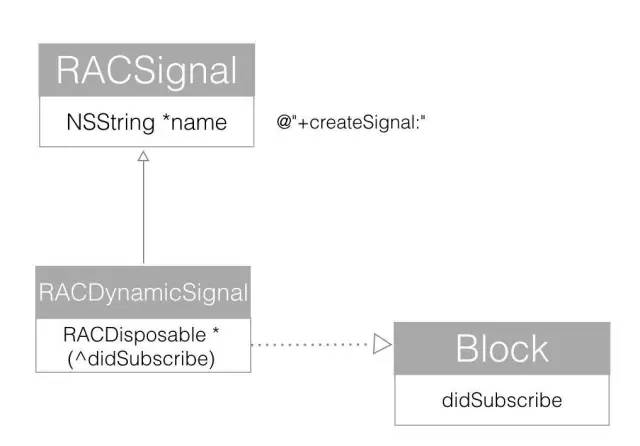
RACSignal的block就这样被保存起来了,那什么时候会被执行呢?
block闭包在订阅的时候才会被“释放”出来。
RACSignal调用subscribeNext方法,返回一个RACDisposable。
- (RACDisposable *)subscribeNext:(void (^)(id x))nextBlock error:(void (^)(NSError *error))errorBlock completed:(void (^)(void))completedBlock {
NSCParameterAssert(nextBlock != NULL);
NSCParameterAssert(errorBlock != NULL);
NSCParameterAssert(completedBlock != NULL);
RACSubscriber *o = [RACSubscriber subscriberWithNext:nextBlock error:errorBlock completed:completedBlock];
return [self subscribe:o];
}
在这个方法中会新建一个RACSubscriber对象,并传入nextBlock,errorBlock,completedBlock。
@interface RACSubscriber ()
// These callbacks should only be accessed while synchronized on self.
@property (nonatomic, copy) void (^next)(id value);
@property (nonatomic, copy) void (^error)(NSError *error);
@property (nonatomic, copy) void (^completed)(void);
@property (nonatomic, strong, readonly) RACCompoundDisposable *disposable;
@end
RACSubscriber这个类很简单,里面只有4个属性,分别是nextBlock,errorBlock,completedBlock和一个RACCompoundDisposable信号。
+ (instancetype)subscriberWithNext:(void (^)(id x))next error:(void (^)(NSError *error))error completed:(void (^)(void))completed {
RACSubscriber *subscriber = [[self alloc] init];
subscriber->_next = [next copy];
subscriber->_error = [error copy];
subscriber->_completed = [completed copy];
return subscriber;
}

subscriberWithNext方法把传入的3个block都保存分别保存到自己对应的block中。
RACSignal调用subscribeNext方法,最后return的时候,会调用[self subscribe:o],这里实际是调用了RACDynamicSignal类里面的subscribe方法。
- (RACDisposable *)subscribe:(id)subscriber {
NSCParameterAssert(subscriber != nil);
RACCompoundDisposable *disposable = [RACCompoundDisposable compoundDisposable];
subscriber = [[RACPassthroughSubscriber alloc] initWithSubscriber:subscriber signal:self disposable:disposable];
if (self.didSubscribe != NULL) {
RACDisposable *schedulingDisposable = [RACScheduler.subscriptionScheduler schedule:^{
RACDisposable *innerDisposable = self.didSubscribe(subscriber);
[disposable addDisposable:innerDisposable];
}];
[disposable addDisposable:schedulingDisposable];
}
return disposable;
}
RACDisposable有3个子类,其中一个就是RACCompoundDisposable。
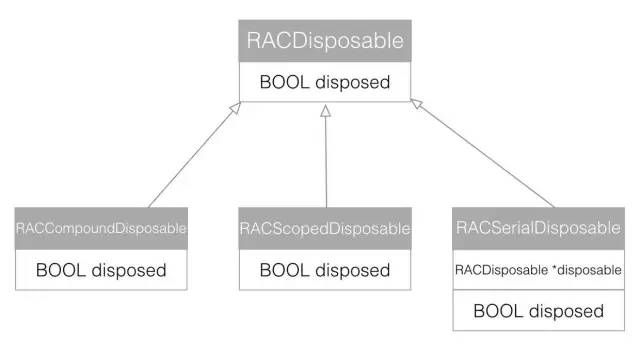
@interface RACCompoundDisposable : RACDisposable
+ (instancetype)compoundDisposable;
+ (instancetype)compoundDisposableWithDisposables:(NSArray *)disposables;
- (void)addDisposable:(RACDisposable *)disposable;
- (void)removeDisposable:(RACDisposable *)disposable;
@end
RACCompoundDisposable虽然是RACDisposable的子类,但是它里面可以加入多个RACDisposable对象,在必要的时候可以一口气都调用dispose方法来销毁信号。当RACCompoundDisposable对象被dispose的时候,也会自动dispose容器内的所有RACDisposable对象。
RACPassthroughSubscriber是一个私有的类。
@interface RACPassthroughSubscriber : NSObject
@property (nonatomic, strong, readonly) id innerSubscriber;
@property (nonatomic, unsafe_unretained, readonly) RACSignal *signal;
@property (nonatomic, strong, readonly) RACCompoundDisposable *disposable;
- (instancetype)initWithSubscriber:(id)subscriber signal:(RACSignal *)signal disposable:(RACCompoundDisposable *)disposable;
@end
RACPassthroughSubscriber类就只有这一个方法。目的就是为了把所有的信号事件从一个订阅者subscriber传递给另一个还没有disposed的订阅者subscriber。
RACPassthroughSubscriber类中保存了3个非常重要的对象,RACSubscriber,RACSignal,RACCompoundDisposable。RACSubscriber是待转发的信号的订阅者subscriber。RACCompoundDisposable是订阅者的销毁对象,一旦它被disposed了,innerSubscriber就再也接受不到事件流了。
这里需要注意的是内部还保存了一个RACSignal,并且它的属性是unsafe_unretained。这里和其他两个属性有区别, 其他两个属性都是strong的。这里之所以不是weak,是因为引用RACSignal仅仅只是一个DTrace probes动态跟踪技术的探针。如果设置成weak,会造成没必要的性能损失。所以这里仅仅是unsafe_unretained就够了。
- (instancetype)initWithSubscriber:(id)subscriber signal:(RACSignal *)signal disposable:(RACCompoundDisposable *)disposable {
NSCParameterAssert(subscriber != nil);
self = [super init];
if (self == nil) return nil;
_innerSubscriber = subscriber;
_signal = signal;
_disposable = disposable;
[self.innerSubscriber didSubscribeWithDisposable:self.disposable];
return self;
}
回到RACDynamicSignal类里面的subscribe方法中,现在新建好了RACCompoundDisposable和RACPassthroughSubscriber对象了。
if (self.didSubscribe != NULL) {
RACDisposable *schedulingDisposable = [RACScheduler.subscriptionScheduler schedule:^{
RACDisposable *innerDisposable = self.didSubscribe(subscriber);
[disposable addDisposable:innerDisposable];
}];
[disposable addDisposable:schedulingDisposable];
}
RACScheduler.subscriptionScheduler是一个全局的单例。
+ (instancetype)subscriptionScheduler {
static dispatch_once_t onceToken;
static RACScheduler *subscriptionScheduler;
dispatch_once(&onceToken, ^{
subscriptionScheduler = [[RACSubscriptionScheduler alloc] init];
});
return subscriptionScheduler;
}
RACScheduler再继续调用schedule方法。
- (RACDisposable *)schedule:(void (^)(void))block {
NSCParameterAssert(block != NULL);
if (RACScheduler.currentScheduler == nil) return [self.backgroundScheduler schedule:block];
block();
return nil;
}
+ (BOOL)isOnMainThread {
return [NSOperationQueue.currentQueue isEqual:NSOperationQueue.mainQueue] || [NSThread isMainThread];
}
+ (instancetype)currentScheduler {
RACScheduler *scheduler = NSThread.currentThread.threadDictionary[RACSchedulerCurrentSchedulerKey];
if (scheduler != nil) return scheduler;
if ([self.class isOnMainThread]) return RACScheduler.mainThreadScheduler;
return nil;
}
在取currentScheduler的过程中,会判断currentScheduler是否存在,和是否在主线程中。如果都没有,那么就会调用后台backgroundScheduler去执行schedule。
schedule的入参就是一个block,执行schedule的时候会去执行block。也就是会去执行:
RACDisposable *innerDisposable = self.didSubscribe(subscriber);
[disposable addDisposable:innerDisposable];
这两句关键的语句。之前信号里面保存的block就会在此处被“释放”执行。self.didSubscribe(subscriber)这一句就执行了信号保存的didSubscribe闭包。
在didSubscribe闭包中有sendNext,sendError,sendCompleted,执行这些语句会分别调用RACPassthroughSubscriber里面对应的方法。
- (void)sendNext:(id)value {
if (self.disposable.disposed) return;
if (RACSIGNAL_NEXT_ENABLED()) {
RACSIGNAL_NEXT(cleanedSignalDescription(self.signal), cleanedDTraceString(self.innerSubscriber.description), cleanedDTraceString([value description]));
}
[self.innerSubscriber sendNext:value];
}
- (void)sendError:(NSError *)error {
if (self.disposable.disposed) return;
if (RACSIGNAL_ERROR_ENABLED()) {
RACSIGNAL_ERROR(cleanedSignalDescription(self.signal), cleanedDTraceString(self.innerSubscriber.description), cleanedDTraceString(error.description));
}
[self.innerSubscriber sendError:error];
}
- (void)sendCompleted {
if (self.disposable.disposed) return;
if (RACSIGNAL_COMPLETED_ENABLED()) {
RACSIGNAL_COMPLETED(cleanedSignalDescription(self.signal), cleanedDTraceString(self.innerSubscriber.description));
}
[self.innerSubscriber sendCompleted];
}
这个时候的订阅者是RACPassthroughSubscriber。RACPassthroughSubscriber里面的innerSubscriber才是最终的实际订阅者,RACPassthroughSubscriber会把值再继续传递给innerSubscriber。
- (void)sendNext:(id)value {
@synchronized (self) {
void (^nextBlock)(id) = [self.next copy];
if (nextBlock == nil) return;
nextBlock(value);
}
}
- (void)sendError:(NSError *)e {
@synchronized (self) {
void (^errorBlock)(NSError *) = [self.error copy];
[self.disposable dispose];
if (errorBlock == nil) return;
errorBlock(e);
}
}
- (void)sendCompleted {
@synchronized (self) {
void (^completedBlock)(void) = [self.completed copy];
[self.disposable dispose];
if (completedBlock == nil) return;
completedBlock();
}
}
innerSubscriber是RACSubscriber,调用sendNext的时候会先把自己的self.next闭包copy一份,再调用,而且整个过程还是线程安全的,用@synchronized保护着。最终订阅者的闭包在这里被调用。
sendError和sendCompleted也都是同理。
总结一下:

-
RACSignal调用subscribeNext方法,新建一个RACSubscriber。
-
新建的RACSubscriber会copy,nextBlock,errorBlock,completedBlock存在自己的属性变量中。
-
RACSignal的子类RACDynamicSignal调用subscribe方法。
-
新建RACCompoundDisposable和RACPassthroughSubscriber对象。RACPassthroughSubscriber分别保存对RACSignal,RACSubscriber,RACCompoundDisposable的引用,注意对RACSignal的引用是unsafe_unretained的。
-
RACDynamicSignal调用didSubscribe闭包。先调用RACPassthroughSubscriber的相应的sendNext,sendError,sendCompleted方法。
-
RACPassthroughSubscriber再去调用self.innerSubscriber,即RACSubscriber的nextBlock,errorBlock,completedBlock。注意这里调用同样是先copy一份,再调用闭包执行。
三. RACSignal操作的核心bind实现
在RACSignal的源码里面包含了两个基本操作,concat和zipWith。不过在分析这两个操作之前,先来分析一下更加核心的一个函数,bind操作。
先来说说bind函数的作用:
-
会订阅原始的信号。
-
任何时刻原始信号发送一个值,都会绑定的block转换一次。
-
一旦绑定的block转换了值变成信号,就立即订阅,并把值发给订阅者subscriber。
-
一旦绑定的block要终止绑定,原始的信号就complete。
-
当所有的信号都complete,发送completed信号给订阅者subscriber。
-
如果中途信号出现了任何error,都要把这个错误发送给subscriber
- (RACSignal *)bind:(RACStreamBindBlock (^)(void))block {
NSCParameterAssert(block != NULL);
return [[RACSignal createSignal:^(id subscriber) {
RACStreamBindBlock bindingBlock = block();
NSMutableArray *signals = [NSMutableArray arrayWithObject:self];
RACCompoundDisposable *compoundDisposable = [RACCompoundDisposable compoundDisposable];
void (^completeSignal)(RACSignal *, RACDisposable *) = ^(RACSignal *signal, RACDisposable *finishedDisposable) { /*这里暂时省略*/ };
void (^addSignal)(RACSignal *) = ^(RACSignal *signal) { /*这里暂时省略*/ };
@autoreleasepool {
RACSerialDisposable *selfDisposable = [[RACSerialDisposable alloc] init];
[compoundDisposable addDisposable:selfDisposable];
RACDisposable *bindingDisposable = [self subscribeNext:^(id x) {
// Manually check disposal to handle synchronous errors.
if (compoundDisposable.disposed) return;
BOOL stop = NO;
id signal = bindingBlock(x, &stop);
@autoreleasepool {
if (signal != nil) addSignal(signal);
if (signal == nil || stop) {
[selfDisposable dispose];
completeSignal(self, selfDisposable);
}
}
} error:^(NSError *error) {
[compoundDisposable dispose];
[subscriber sendError:error];
} completed:^{
@autoreleasepool {
completeSignal(self, selfDisposable);
}
}];
selfDisposable.disposable = bindingDisposable;
}
return compoundDisposable;
}] setNameWithFormat:@"[%@] -bind:", self.name];
}
为了弄清楚bind函数究竟做了什么,写出测试代码:
RACSignal *signal = [RACSignal createSignal:
^RACDisposable *(id subscriber)
{
[subscriber sendNext:@1];
[subscriber sendNext:@2];
[subscriber sendNext:@3];
[subscriber sendCompleted];
return [RACDisposable disposableWithBlock:^{
NSLog(@"signal dispose");
}];
}];
RACSignal *bindSignal = [signal bind:^RACStreamBindBlock{
return ^RACSignal *(NSNumber *value, BOOL *stop){
value = @(value.integerValue * 2);
return [RACSignal return:value];
};
}];
[bindSignal subscribeNext:^(id x) {
NSLog(@"subscribe value = %@", x);
}];
由于前面第一章节详细讲解了RACSignal的创建和订阅的全过程,这个也为了方法讲解,创建RACDynamicSignal,RACCompoundDisposable,RACPassthroughSubscriber这些都略过,这里着重分析一下bind的各个闭包传递创建和订阅的过程。
为了防止接下来的分析会让读者看晕,这里先把要用到的block进行编号。
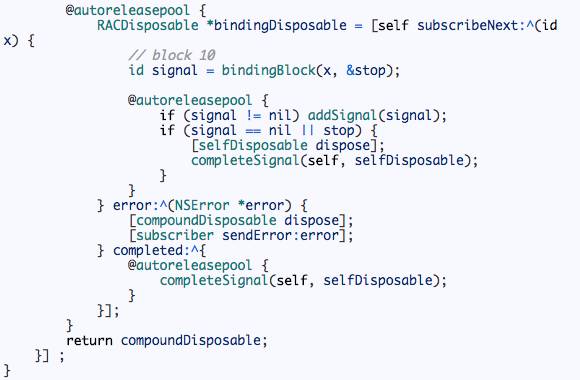
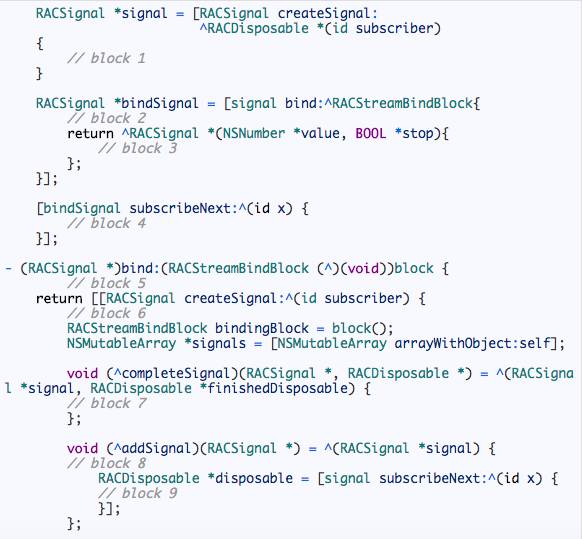
先创建信号signal,didSubscribe把block1 copy保存起来。
-
bindSignal执行didSubscribe的block,即执行block6。
-
在block6 的第一句代码,就是调用RACStreamBindBlock bindingBlock = block(),这里的block是外面传进来的block2,于是开始调用block2。执行完block2,会返回一个RACStreamBindBlock的对象。
-
由于是signal调用的bind函数,所以bind函数里面的self就是signal,在bind内部订阅了signal的信号。subscribeNext所以会执行block1。
-
执行block1,sendNext调用订阅者subscriber的nextBlock,于是开始执行block10。
-
block10中会先调用bindingBlock,这个是之前调用block2的返回值,这个RACStreamBindBlock对象里面保存的是block3。所以开始调用block3。
-
在block3中入参是一个value,这个value是signal中sendNext中发出来的value的值,在block3中可以对value进行变换,变换完成后,返回一个新的信号signal’。
-
如果返回的signal’为空,则会调用completeSignal,即调用block7。block7中会发送sendCompleted。如果返回的signal’不为空,则会调用addSignal,即调用block8。block8中会继续订阅signal’。执行block9。
-
block9 中会sendNext,这里的subscriber是block6的入参,于是对subscriber调用sendNext,会调用到bindSignal的订阅者的block4中。
-
block9 中执行完sendNext,还会调用sendCompleted。这里的是在执行block9里面的completed闭包。completeSignal(signal, selfDisposable);然后又会调用completeSignal,即block7。
-
执行完block7,就完成了一次从signal 发送信号sendNext的全过程。
bind整个流程就完成了。
四. RACSignal基本操作concat和zipWith实现
接下来再来分析RACSignal中另外2个基本操作。
1. concat
写出测试代码:
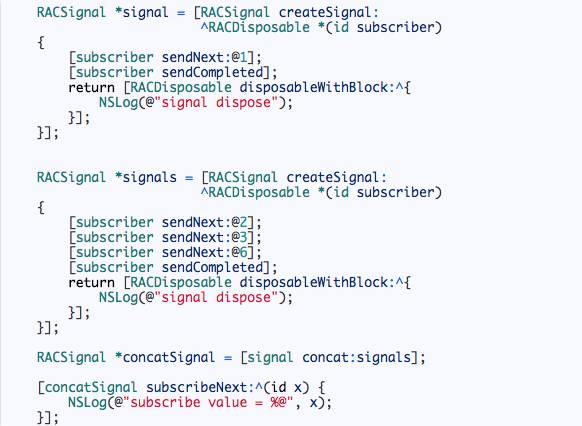
concat操作就是把两个信号合并起来。注意合并有先后顺序。
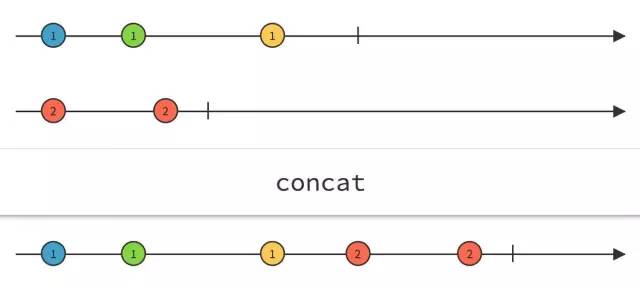

合并前,signal和signals
dSubscribe会把block保存copy起来。
当合并之后的信号被订阅的时候:
-
调用新的合并信号的didSubscribe。
-
由于是第一个信号调用的concat方法,所以block中的self是前一个信号signal。合并信号的didSubscribe会先订阅signal。
-
由于订阅了signal,于是开始执行signal的didSubscribe,sendNext,sendError。
-
当前一个信号signal发送sendCompleted之后,就会开始订阅后一个信号signals,调用signals的didSubscribe。
-
由于订阅了后一个信号,于是后一个信号signals开始发送sendNext,sendError,sendCompleted。
这样两个信号就前后有序的拼接到了一起。
这里有二点需要注意的是:
-
只有当第一个信号完成之后才能收到第二个信号的值,因为第二个信号是在第一个信号completed的闭包里面订阅的,所以第一个信号不结束,第二个信号也不会被订阅。
-
两个信号concat在一起之后,新的信号的结束信号在第二个信号结束的时候才结束。看上图描述,新的信号的发送长度等于前面两个信号长度之和,concat之后的新信号的结束信号也就是第二个信号的结束信号。
2. zipWith
写出测试代码:
RACSignal *concatSignal = [signal zipWith:signals];
[concatSignal subscribeNext:^(id x) {
NSLog(@"subscribe value = %@", x);
}];

源码如下:
当把两个信号通过

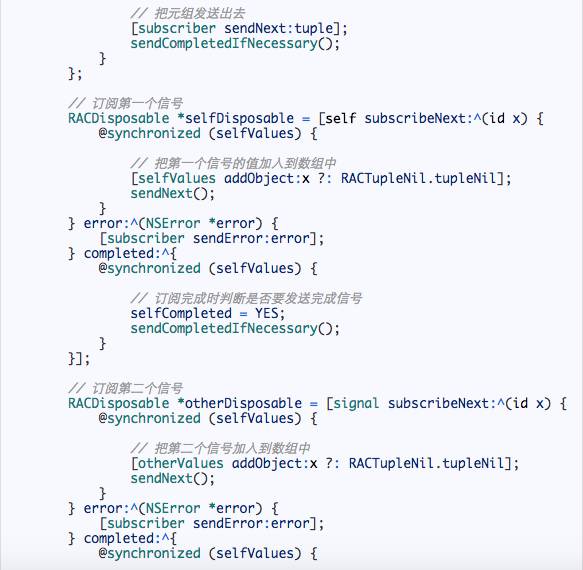

是有对应的,上面的拉链第一个位置只能对着下面拉链第一个位置,这样拉链才能拉到一起去。
具体实现:
zipWith里面有两个数组,分别会存储两个信号的值。
-
一旦订阅了zipWith之后的信号,就开始执行didSubscribe闭包。
-
在闭包中会先订阅第一个信号。这里假设第一个信号比第二个信号先发出一个值。第一个信号发出来的每一个值都会被加入到第一个数组中保存起来,然后调用sendNext( )闭包。在sendNext( )闭包中,会先判断两个数组里面是否都为空,如果有一个数组里面是空的,就return。由于第二个信号还没有发送值,即第二个信号的数组里面是空的,所以这里第一个值发送不出来。于是第一个信号被订阅之后,发送的值存储到了第一个数组里面了,没有发出去。
-
第二个信号的值紧接着发出来了,第二个信号每发送一次值,也会存储到第二个数组中,但是这个时候再调用sendNext( )闭包的时候,不会再return了,因为两个数组里面都有值了,两个数组的第0号位置都有一个值了。有值以后就打包成元组RACTuple发送出去。并清空两个数组0号位置存储的值。
-
以后两个信号每次发送一个,就先存储在数组中,只要有“配对”的另一个信号,就一起打包成元组RACTuple发送出去。从图中也可以看出,zipWith之后的新信号,每个信号的发送时刻是等于两个信号最晚发出信号的时刻。
-
新信号的完成时间,是当两者任意一个信号完成并且数组里面为空,就算完成了。所以最后第一个信号发送的5的那个值就被丢弃了。
第一个信号依次发送的1,2,3,4的值和第二个信号依次发送的A,B,C,D的值,一一的合在了一起,就像拉链把他们拉在一起。由于5没法配对,所以拉链也拉不上了。
五. 最后
本来这篇文章想把Map,combineLatest,flattenMap,flatten这些也一起分析了,但是后来看到RACSingnal的操作实在有点多,于是按照源码的文件分开了,这里先把RACSignal文件里面的操作都分析完了。RACSignal文件里面的操作主要就bind,concat和zipWith三个操作。下一篇再分析分析RACSignal+Operations文件里面的所有操作。